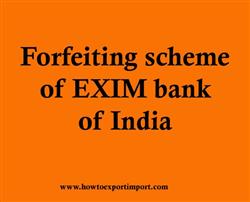Forfeiting scheme of EXIM bank of India
The term forfeiting comes from the French expression 'forfeit' which means 'surrender of certain rights: Forfeiting is a method of getting payment for exports by the exporter. The forfeiting agency discounts trade receivables of the exporter, without any recourse to him, in the unlikely event of the buyer not paying for the transaction. Trade receivables include bills of exchange, promissory notes, book receivables and deferred payments under letter of credit.
 Export- import Bank of India (EXIM) acts as the facilitator and the nodal agency. In the course of the export transaction entered into between the exporter and the Importer, the exporter surrenders all his claims on the export receivables in favour of the forfeiter. The forfeiter in turn remits the discounted value to the exporter in exchange of the debts instruments used in the transaction, usually promissory notes or bills of exchange. Thus, forfeiting converts the exporter's credit sates into to cash sales. By converting the exporter's credit sales into cash sales, the forfeiter Protects exporter from all the risks associated with selling overseas on credit.
Export- import Bank of India (EXIM) acts as the facilitator and the nodal agency. In the course of the export transaction entered into between the exporter and the Importer, the exporter surrenders all his claims on the export receivables in favour of the forfeiter. The forfeiter in turn remits the discounted value to the exporter in exchange of the debts instruments used in the transaction, usually promissory notes or bills of exchange. Thus, forfeiting converts the exporter's credit sates into to cash sales. By converting the exporter's credit sales into cash sales, the forfeiter Protects exporter from all the risks associated with selling overseas on credit.
Mechanics of Forfeiting:
The importer prepares promissory notes that are guaranteed by a bank. These are sent to the exporter, who then sells them for cash to a forfeiting bank. The bank may then sell the notes. The holder of the notes has no recourse to the exporter. On delivery of the goods, the importer makes payment to his bank and in turn his bank honours the note.
The charges of the forfeiter are based on the LIBOR (London Inter Bank Offer Rate). Over and above that, he adds a margin called 'spread' consisting of commitment fee, discount fee and documentation fee, if any.
The 'spread' is influenced by the credit period and the country. The longer the credit period or riskier the destination of exports, the greater the spread.
Advantages of Forfeiting:
(a) The exporter receives the payment immediately and hence a credit transaction becomes the cash transaction.
(b) It converts a deterred payment export into a cash transaction, improving the liquidity and cash flow.
(c) It protects the exporter against all types of commercial and political risks associated with the realization of export proceeds.
(d) It provides finance to the extent of 100% of the export value as compared to the conventional export credit programmes whereby only 80-85% of the financing was available.
(e) The method is useful for small and medium sized exporters, who may have sound and creditworthy buyers abroad, but are not able to take the risk of bearing the credit burden.
Import General Manifest (IGM)
Importance of Bill of Lading
Introduction to this web site.
Is Airway bill a documents of title?
Is Customs House Agents (CHA ) required to be appointed mandatory?
Is DP terms of payment safe in export business?
Is Letter of Credit LC safe for an Importer?
Is ON BOARD CERTIFICATE required for LC negotiation
Is Received for shipment Bill of Lading sufficient for LC negotiation?
Is Risk Management System (RMS) simplify import? What is RMS in import.
Is sales tax applicable on shipments effected under high sea sales
Is Seaway bill a document of title? What is Seaway bill.
Is THC same in all ports
KINDS OF LOSSES in Marine Insurance
Know the term Port of Discharge and Place of Delivery
LC advantage exporter
LC advantage importer
LC parties